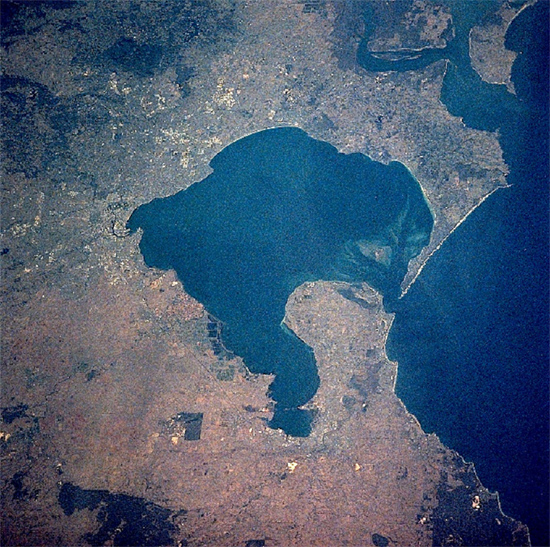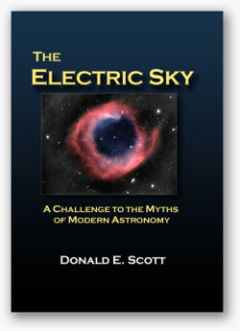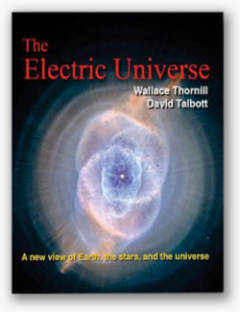|
|
|

Port Phillip Bay from the Challenger
Space Shuttle.
Credit: Image Science and Analysis
Laboratory, NASA-Johnson Space
Center
The 'Little Ice Age' on
Melbourne's Port Phillip Bay
May 04, 2011
Imagine the yachts of
Mornington harbour locked up in
meters of thick ice.
Picture our pride and joy, maxi
yacht Wild Thing, with its
tackle caked in icicles and skipper
Grant Warrington clad in fur skins.
Imagine yourself down at the Portsea
headlands, looking across at the ice
blocking the passage of massive
container ships trying to get into
the once thriving Melbourne
Docklands.
'Impossible!' you say, but research
has shown that just such a scenario
probably occurred in Victoria and
only a few short centuries ago. What
happened?
The 'Little Ice Age' period is a
scientific reconstruction that
includes the time from 1300 AD to
approximately 1820 AD when there was
a dramatic and erratic climate
deterioration. The Little Ice Age is
classified into four periods: the
Wolf, Sporer, Maunder, and Dalton
Minima respectively. They were
interspaced with relatively stable
periods before. These deteriorations
were not only cooler and wetter on
average but vastly more erratic.
Such erratic climate extremes are
prime ingredients for famine,
plague, and the abandonment of human
settlements. They followed a period
known as the 'Medieval warm
maximum', which lasted from 900 AD
to around 1300 AD That time was much
hotter than the present. It was a
prosperous era that saw the
expansion of the Viking tribes into
Iceland, Greenland, Vinland
(America), and Russia. Grape vines
were grown in warm meadows in what
are now cold snowy countries, while
great herds of sheep and cattle
roamed their now inhospitable
coastlines.
However, the Little Ice Age was a
global phenomenon. In the Southern
Hemisphere, the expansion of the
Polynesian peoples occurred From New
Zealand to Hawaii and Tahiti. These
bold sea peoples resettled the
Pacific.
Then, dramatically, the first trough
of the Little Ice Age hit with
terrible, tragic severity. Erratic
minima periods saw the formation of
thick sea ice 10 kilometers into the
English channel. Major rivers, such
as the Thames in London, were frozen
for much of the year. Perhaps the
River Murray followed suit. The
world was hit with particularly
severe storms such as the one that
wrecked the Spanish Armada in 1588
AD. Glaciers destroyed many
prosperous villages. High rainfall
and much colder climates were
recorded in unstable sequences.
Not coincidentally, the opening
thrusts of the Little Ice Age saw a
period of major plagues and famines
that ravaged Europe and the rest of
the world. It was a global
phenomenon. The causes were probably
the underlying forces that drive
weather systems, which Plimer argues
are largely due to the influence of
sunspot minima. Coronal mass
ejections are likely to be another
related contributor. These periods
of high cosmic ray bombardment cause
increased positive ion concentration
in Earth's atmosphere. Fred Soyka
claims this causes bacteria to
become highly virulent and invasive.
Black Death, Plague, and other
relentless infections follow.
The plagues and famines attending
the Little Ice Age were devastating.
Estimates record that the population
of the Mediterranean basin was
reduced to a third. For instance,
the plague of 1347 AD depopulated
Europe so badly that it took two
hundred and fifty years for it to
return to its pre-plague population.
A similar scenario might easily have
occurred in the Aboriginal
population before white settlement.
Archaeologist Hiscock reports that
around the 1750s there was
significant depopulation of tribes
in Australia due to epidemics. This
may have been encouraged by the last
phase of the Little Ice Age, the
Dalton minimum.
The Viking settlement of Greenland
became ice bound and the population
perished. In Iceland, the population
was greatly reduced and became
stunted physiologically. Agriculture
and fishing had to be largely
abandoned. Did similar shocks occur
in Australia?
Proof that the Little Ice Age
occurred in Australia is forthcoming
from many sources. Reconstruction of
sea temperatures from Coral cores
(Handy et al.), stalagmite isotopic
oxygen ratios (Wilson et al.), and
Glacial studies in New Zealand
(Winkler) confirmed that the
Southern hemisphere mimicked the
erratic temperature changes of the
United States and Europe.
So where does this lead us? First,
as Professor Ian Plimer concludes,
the Little Ice Age was in no way due
to the hand of mankind. Of equal
importance, many scientists contend
that the earlier Medieval and Roman
warming's were much hotter than our
modern warm period despite lower
carbon dioxide levels.
How can we possibly contend that our
modern warming is due to mankind and
his unwelcome industrial pollution?
Fumes and effluent may be obnoxious
but they do not cause climate
change. The issue is aesthetics not
a proven greenhouse effect. Is a
proposed Carbon tax a childish waste
of time? Do we really think we can
control the weather?
Peter Mungo Jupp
For more on the Little Ice Age
visit:
www.ancientdestructions.com
 New
DVD New
DVD
The Lightning-Scarred
Planet Mars
A video documentary that could
change everything you thought you
knew about ancient times and
symbols. In this second episode of
Symbols of an Alien Sky, David
Talbott takes the viewer on an
odyssey across the surface of Mars.
Exploring feature after feature of
the planet, he finds that only
electric arcs could produce the
observed patterns. The high
resolution images reveal massive
channels and gouges, great mounds,
and crater chains, none finding an
explanation in traditional geology,
but all matching the scars from
electric discharge experiments in
the laboratory. (Approximately 85
minutes)
Video Selections
Order Link
|
|
|
|
|
|
|
|
|
YouTube video, first glimpses of Episode Two in the "Symbols of an Alien Sky"
series.
|
|
|
|
|
|
|
Three ebooks in the Universe Electric series are
now available. Consistently
praised for easily understandable text and exquisite graphics.
|
|
|
|
|
|
|
|
|
|





 New
DVD
New
DVD

